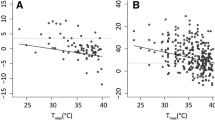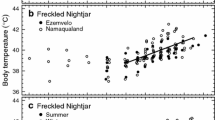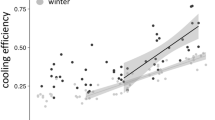Abstract
Avian responses to high environmental temperatures include retreating to cooler microsites and/or increasing rates of evaporative heat dissipation via panting, both of which may affect foraging success. We hypothesized that behavioural trade-offs constrain the maintenance of avian body condition in hot environments, and tested predictions arising from this hypothesis for male Southern Yellow-billed Hornbills (Tockus leucomelas) breeding in the Kalahari Desert. Operative temperatures experienced by the hornbills varied by up to 13 °C among four microsite categories used by foraging males. Lower prey capture rates while panting and reductions associated with the occupancy of off-ground microsites, resulted in sharp declines in foraging efficiency during hot weather. Consequently, male body mass (Mb) gain between sunrise and sunset decreased with increasing daily maximum air temperature (Tmax), from ~ 5% when Tmax < 25 °C to zero when Tmax = 38.4 °C. Overnight Mb loss averaged ~ 4.5% irrespective of Tmax, creating a situation where nett 24-h Mb loss approached 5% on extremely hot days. These findings support the notion that temperature is a major determinant of body condition for arid-zone birds. Moreover, the strong temperature dependence of foraging success and body condition among male hornbills provisioning nests raises the possibility that male behavioural trade-offs translate into equally strong effects of hot weather on female condition and nest success. Our results also reveal how rapid anthropogenic climate change is likely to substantially decrease the probability of arid-zone birds like hornbills being able to successfully provision nests while maintaining their own condition.



Similar content being viewed by others
References
Abadi F, Barbraud C, Gimenez O (2017) Integrated population modeling reveals the impact of climate on the survival of juvenile emperor penguins. Glob Change Biol 23:1353–1359
Albright TP et al (2017) Mapping evaporative water loss in desert passerines reveals an expanding threat of lethal dehydration. Proc Natl Acad Sci 114:2283–2288
AlRashidi M, Kosztolányi A, Küpper C, Cuthill IC, Javed S, Székely T (2010) The influence of a hot environment on parental cooperation of a ground-nesting shorebird, the Kentish plover Charadrius alexandrinus. Front Zool 7:1
Angilletta MJ Jr, Cooper BS, Schuler MS, Boyles JG (2010) The evolution of thermal physiology in endotherms. Front Biosci E2:861–881
Bacigalupe LD, Rezende EL, Kenagy GJ, Bozinovic F (2003) Activity and space use by degus: a trade-off between thermal conditions and food availability? J Mamm 84:311–318
Bakken GS (1976) A heat transfer analysis of animals: unifying concepts and the application of metabolism chamber data to field ecology. J Theor Biol 60:337–384
Bakken GS (1980) The use of standard operative temperature in the study of the thermal energetics of birds. Physiol Zool 53:108–119
Bartoń K (2013) MuMIn: multi-model inference. R package version 1(9):13
Bates D, Maechler M, Bolker B, Walker S (2014) lme4: Linear mixed-effects models using Eigen and S4. R package version 1.1-7, http://CRAN.R-project.org/package=lme4
Bennett AF, Huey RB, John-Alder H, Nagy KA (1984) The parasol tail and thermoregulatory behavior of the cape ground squirrel Xerus inauris. Physiol Zool 57:57–62
Camacho A, Rodrigues MT, Navas C (2015) Extreme operative temperatures are better descriptors of the thermal environment than mean temperatures. J Therm Biol 49:106–111
Carroll JM, Davis CA, Elmore RD, Fuhlendorf SD, Thacker ET (2015) Thermal patterns constrain diurnal behavior of a ground-dwelling bird. Ecosphere 6:1–15
Cerdá X, Retana J, Cros S (1998) Critical thermal limits in Mediterranean ant species: trade-off between mortality risk and foraging performance. Funct Ecol 12:45–55
Clark L (1987) Thermal constraints on foraging in adult European starlings. Oecol 71:233–238
Clutton-Brock TH et al (1999) Predation, group size and mortality in a cooperative mongoose, Suricata suricatta. J Anim Ecol 68:672–683
Cresswell W (2008) Non-lethal effects of predation in birds. Ibis 150:3–17
Cunningham SJ, Kruger AC, Nxumalo MP, Hockey PAR (2013) Identifying biologically meaningful hot-weather events using threshold temperatures that affect life-history. PLoS One 8:e82492
Cunningham SJ, Martin RO, Hockey PA (2015) Can behaviour buffer the impacts of climate change on an arid-zone bird? Ostrich 86:119–126
Dawson WR (1954) Temperature regulation and water requirements of the brown and Abert towhees, Pipilo fuscus and Pipilo aberti. In: Bartholomew GA, Crescitelli F, Bullock TH, Furgason WH, Schechtman AM (eds) University of California publications in zoology, vol 59. University of California Press, Berkeley, pp 81–123
Dawson WR (1982) Evaporative losses of water by birds. Comp Biochem Physiol 71A:495–509
du Plessis KL, Martin RO, Hockey PAR, Cunningham SJ, Ridley AR (2012) The costs of keeping cool in a warming world: implications of high temperatures for foraging, thermoregulation and body condition of an arid-zone bird. Glob Change Biol 18:3063–3070
Edwards EK, Mitchell NJ, Ridley AR (2015) The impact of high temperatures on foraging behaviour and body condition in the Western Australian Magpie Cracticus tibicen dorsalis. Ostrich 86:137–144
Engelbrecht F et al (2015) Projections of rapidly rising surface temperatures over Africa under low mitigation. Environ Res Lett 10:085004
Hall LE, Chalfoun AD, Beever EA, Loosen AE (2016) Microrefuges and the occurrence of thermal specialists: implications for wildlife persistence amidst changing temperatures. Clim Change Responses 3:8
Hetem RS et al (2012) Activity re-assignment and microclimate selection of free-living Arabian oryx: responses that could minimise the effects of climate change on homeostasis? Zoology 115:411–416
Hovick TJ, Elmore RD, Allred BW, Fuhlendorf SD, Dahlgren DK (2014) Landscapes as a moderator of thermal extremes: a case study from an imperiled grouse. Ecosphere 5:1–12
Huey RB, Kearney MR, Krockenberger A, Holtum JAM, Jess M, Williams SE (2012) Predicting organismal vulnerability to climate warming: roles of behaviour, physiology and adaptation. Philos Trans R Soc Lond B 367:1665–1679
Kearney M, Shine R, Porter WP (2009) The potential for behavioral thermoregulation to buffer “cold-blooded” animals against climate warming. Proc Natl Acad Sci 106:3835–3840
Kemp AC, Woodcock M (1995) The hornbills: Bucerotiformes. Oxford University Press, USA
Klaassen M, Brenninkmeijer A, Boix-Hinzen C, Mendelsohn J (2003) Fathers with highly demanding partners and offspring in a semidesert environment: energetic aspects of the breeding system of Monteiro’s hornbills (Tockus monteiri) in Namibia. Auk 120:866–873
Kruger A, Sekele S (2013) Trends in extreme temperature indices in South Africa: 1962–2009. Int J Climatol 33:661–676
Lack D (1948) The significance of clutch size III. Some interspecific comparisons. Ibis 90:25–45
Lack D (1954) The natural regulation of animal numbers. Claredon Press, Oxford
Marder J, Gavrieli-Levin I (1986) Body and egg temperature regulation in incubating pigeons exposed to heat stress: the role of skin evaporation. Physiol Zool 69:532–538
Martin RO, Cunningham SJ, Hockey PA (2015) Elevated temperatures drive fine-scale patterns of habitat use in a savanna bird community. Ostrich 86:127–135
Mason TH, Brivio F, Stephens PA, Apollonio M, Grignolio S (2017) The behavioral trade-off between thermoregulation and foraging in a heat-sensitive species. Behav Ecol 28:908–918
McKechnie AE, Wolf BO (2004) Partitioning of evaporative water loss in white-winged doves: plasticity in response to short-term thermal acclimation. J Exp Biol 207:203–210
McKechnie AE, Wolf BO (2010) Climate change increases the likelihood of catastrophic avian mortality events during extreme heat waves. Biol Let 6:253–256
Moreau R, Moreau WM (1941) Breeding biology of silvery-cheeked hornbill. The Auk 58:13–27
Nowicki JP, Miller GM, Munday PL (2012) Interactive effects of elevated temperature and CO2 on foraging behavior of juvenile coral reef fish. J Exp Mar Biol Ecol 412:46–51
Oswald SA, Arnold JM (2012) Direct impacts of climatic warming on heat stress in endothermic species: seabirds as bioindicators of changing thermoregulatory constraints. Integrative Zool 7:121–136
Owen-Smith N (1998) How high ambient temperature affects the daily activity and foraging time of a subtropical ungulate, the greater kudu (Tragelaphus strepsiceros). J Zool 246:183–192
Robinson DE, Campbell GS, King JR (1976) An evaluation of heat exchange in small birds. J Comp Physiol B 105:153–166
Rosenberg NJ, Blad BL, Verma SB (1983) Microclimate: the biological environment. Wiley, Chichester
Scheffers BR, Edwards DP, Diesmos A, Williams SE, Evans TA (2014) Microhabitats reduce animal’s exposure to climate extremes. Glob Change Biol 20:495–503
Sears MW, Raskin E, Angilletta MJ Jr (2011) The world is not flat: defining relevant thermal landscapes in the context of climate change. Integr Comp Biol 51:666–675
Seymour CL, Dean W (2010) The influence of changes in habitat structure on the species composition of bird assemblages in the southern Kalahari. Austral Ecol 35:581–592
Sinervo B et al (2010) Erosion of lizard diversity by climate change and altered thermal niches. Science 328:894–899
Smith RM, Suthers R (1969) Cutaneous water loss as a significant contribution to temperature regulation in heat stressed pigeons. Physiologist 12:358
Suggitt AJ et al (2011) Habitat microclimates drive fine-scale variation in extreme temperatures. Oikos 120:1–8
Tieleman BI, van Noordwijk HJ, Williams JB (2008) Nest site selection in a hot desert: trade-off between microclimate and predation risk? Condor 110:116–124
Trivers R (1972) Parental investment and sexual selection. Harvard University Cambridge, Biological Laboratories
Trivers RL (1974) Parent-offspring conflict. Integr Comp Biol 14:249–264
van Beest FM, Van Moorter B, Milner JM (2012) Temperature-mediated habitat use and selection by a heat-sensitive northern ungulate. Anim Behav 84:723–735
van Wilgen NJ, Goodall V, Holness S, Chown SL, McGeoch MA (2016) Rising temperatures and changing rainfall patterns in South Africa’s national parks. Int J Climatol 36:706–721
Visser ME (2008) Keeping up with a warming world; assessing the rate of adaptation to climate change. Proc R Soc B 275:649–659
Wathes G, Clark J (1981) Sensible heat transfer from the fowl: thermal resistance of the pelt. Br Poult Sci 22:175–183
Webster MD, Campbell GS, King JR (1985) Cutaneous resistance to water-vapor diffusion in pigeons and the role of the plumage. Physiol Zool 58:58–70
Wiley EM, Ridley AR (2016) The effects of temperature on offspring provisioning in a cooperative breeder. Anim Behav 117:187–195
Williams JB, Tieleman BI, Shobrak M (1999) Lizard burrows provide thermal refugia for larks in the Arabian desert. Condor 101:714–717
Winkler DW, Dunn PO, McCulloch CE (2002) Predicting the effects of climate change on avian life-history traits. Proc Natl Acad Sci 99:13595–13599
Witmer MC (1993) Cooperative breeding by rufous hornbills on Mindanao Island, Philippines. Auk 110:933–936
Wolf BO, Walsberg GE (1996) Thermal effects of radiation and wind on a small bird and implications for microsite selection. Ecology 77:2228–2236
Wuethrich B (2000) How climate change alters rhythms of the wild. Science 287:793–795
Acknowledgements
We thank the De Bruin family of Leeupan farm, the Kotze family of Rus en Vrede farm and the Kalahari Research Trust for support and access provided to their land. We thank R. O. Martin for discussions of operative temperature measurement and S-J. Schultz, T. Vink, D. Portelli and J. Bruning for their help with data collection in the field. This research was conducted under ethical clearance from the Animal Ethics Committee, University of Cape Town, permit no. 2012/V44/PH and 2013/V24/PR. The study was carried out on private land (Kuruman River Reserve, Leeupan Guest Farm and Rus en Vrede farm) with permission of the landowners and of the Northern Cape Department of Environment and Nature Conservation of South Africa (permit numbers 995/2012, 660/2013 and 1166/2013). This research was primarily funded by the DST-NRF Centre of Excellence at the FitzPatrick Institute. Any opinions, findings and conclusions or recommendations expressed in this material are those of the authors and do not necessarily reflect the views of the National Research Foundation.
Author information
Authors and Affiliations
Contributions
SJC, AEM and TMFNVDV conceived and designed the study. TMFNVDV collected data in the field. TMFNVDV analysed the data with input from SJC. SJC, TMFNVDV, and AEM together wrote the manuscript.
Corresponding author
Additional information
Communicated by Mathew Samuel Crowther.
Electronic supplementary material
Below is the link to the electronic supplementary material.
Rights and permissions
About this article
Cite this article
van de Ven, T.M.F.N., McKechnie, A.E. & Cunningham, S.J. The costs of keeping cool: behavioural trade-offs between foraging and thermoregulation are associated with significant mass losses in an arid-zone bird. Oecologia 191, 205–215 (2019). https://doi.org/10.1007/s00442-019-04486-x
Received:
Accepted:
Published:
Issue Date:
DOI: https://doi.org/10.1007/s00442-019-04486-x




